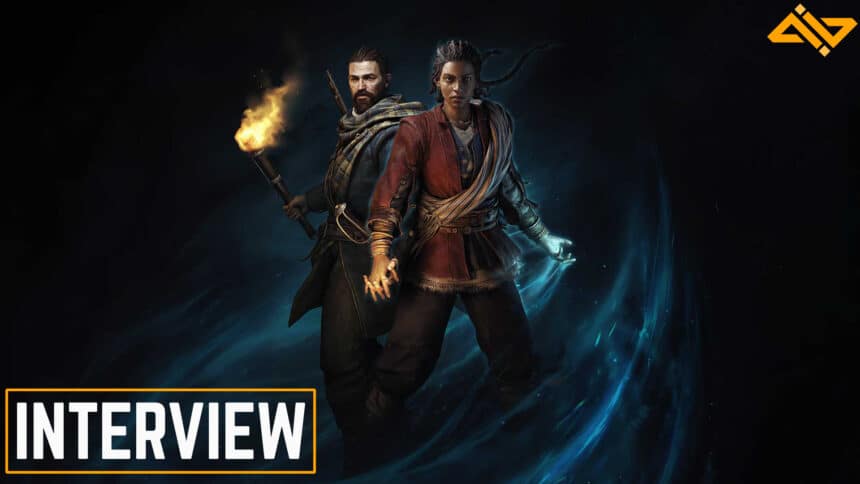Banishers: Ghosts of New Eden is DON’T NOD’s most ambitious title yet, and one of my favorite releases of the year so far. It’s a spiritual successor to Vampyr that builds upon its ideas and follows the heartfelt story of Antea Duarte and Red mac Raith. To discuss the game’s development, narrative choices, and design philosophy, I had a chance to talk with Stéphane Beauverger, the Narrative Director at DON’T NOD for Banishers: Ghosts of New Eden.
Note: The questions for this interview were sent after the release of Banishers: Ghosts of New Eden.
I want to congratulate you on the excellent reviews for Banishers: Ghost of New Eden. Would you like to share your reaction to the positive response from critics and fans alike?
Stéphane Beauverger: Thank you so much. For our teams, who can spend years on a project, it is always heartwarming to receive positive feedback from the audience. We took risks with this game, it was not easy to decide to tell a “mature love story” in an action-RPG. Before the game was released, we were only hoping we had correctly shaped the dynamics of Red and Antea as a couple but also as individuals. Now we know we did it right. Quite a relief, after almost five years spent crafting our banishers’ journey.
Banishers shares striking similarities with Vampyr, almost feeling like a spiritual successor. Was there ever a consideration for it to be a sequel to Vampyr, or was it always intended to be set in a completely different universe?
Stéphane Beauverger: Here is a secret: the two games actually take place in the same universe 🙂 And the most aware players may find some evidence of that, in a few cues, items or readables in the game. For instance, Charles Davenport’s brooch looks a lot like the symbol of the Brotherhood of St Paul’s Stole from Vampyr.

It’s rare to see video games handle romance well, let alone star a couple, yet Antea and Red effortlessly convey intimacy, and a deep bond, despite their circumstances. How difficult was it to get that right, and make it the central focus of the game?
Stéphane Beauverger: It was quite difficult. No, not difficult, more… delicate. To “effortlessly convey intimacy”, we wrote a lot of background about these two characters, about their personal and common past. Actually, we wrote a lot more than what is actually revealed in the game. For instance, we wrote a short story of their first encounter (which, for the record, did not go well for Red, since he did not make a good first impression at all, from Antea’s point of view). And we also wrote down the details of the two first haunting cases they solved together. These enhanced backgrounds were for us a way to carve and improve the authenticity of their bond. When it was finally time to write the most intimate and emotional scenes between them in the game, we really knew who they were, and how they would react to each other in any given situation.

Meaningful decisions, tough choices, and consequences have always been a big part of your narrative titles dating back to Life is Strange. Is there any advice you can give to other developers who want their audience to feel conflicted and genuinely conscious of the choice they’re making? What’s the secret?
Stéphane Beauverger: Do not be afraid to dig deep in the darkest part of your imagination. Do not be afraid to be controversial and radical when crafting villain characters, but also be sure to put yourself in their shoes when writing down their most awful acts. By painting the world and characters in multiple layers of opposite, plausible but morally grey motivations, you will generate dilemmas. You may even make the players accept the terrifying idea of becoming a murderer in the name of love 🙂
One of my only issues with Vampyr was the combat mechanics, and Banishers greatly improves that with a far more involved and fluid system. How did you take feedback to improve this aspect? Were there any major influences?
Corentin Billemont – Senior Combat Designer: Thanks for noticing, it’s great to hear that! We know that Vampyr, while appreciated by many fans, had also received mixed feedback on the combat and controls, and since many combat designers on Banishers didn’t work on Vampyr, we played it again and took those criticisms to heart to create a new vision.
The combat team is really passionate about Action RPGs but also other action-related genres: fighting games, character action, third person shooters…

Many people have noticed, but the modern God of War games have been a big inspiration for us, and even if we didn’t have the budget to compete with them, this still gave us some great lessons and principles. We complemented that with a new pillar, like the real time switch between two protagonists with different movesets and resources, as well as various combat features linked to that: perfect switches (timing), ultimates (fusion of both characters), many RPG skills leading to a deeper moveset…

We’re definitely listening to all the feedback given on Banishers’ combat, positive or negative, and are really looking forward to build upon that experience in our future ARPG projects.
New Eden is a beautiful setting, and I loved exploring the world you’ve created. If you had to tell the same story in a different setting, what would you choose?
Stéphane Beauverger: Anywhere and anywhen, really, as long as the place is inhabited by a bunch of haunted individuals trying to hide, forget or confess what they did or did not do. Preferably in a remarkable landscape, and during a historically difficult time.
I understand that Banishers is technically a “AA” game, but what does that really mean anymore? I’d love to hear your take on what these terms mean to studios, especially in 2024.
Stéphane Beauverger: It means we have limited budget, assets and time, and it means we constantly have to make choices while crafting the game and its features, to make the whole experience coherent within the said limited budget and assets. We often spend a lot of time conceiving the game, then weighing the efficiency of the features during a comfortably long pre-prod, before finally building the whole game during a shortened production time, once we know where our teams are going. On a AA project, you cannot reboot the concept in the middle of the production, and ideally you have to stick to the original plan.

This is probably going to be a difficult question, but who is your favorite character from Banishers, and why?
Stéphane Beauverger: You are right, it’s quite a difficult question. I may be tempted to answer that I am more interested in the dynamics between characters, than by any specific character. The tensions between the Newsmith sisters, for instance, or between Governor Haskell and his son. But if I had to name one character I really like in the game… Well… [Spoiler Alert] Probably the ghost of Sebastian Preese, and the true love he has for his wife, even if based on made up memories.

What should fans look forward to for the future of Banishers: Ghost of New Eden, and the series in general? Have you ever thought of expanding the world to other forms of media?
Stéphane Beauverger: Whenever we create a new game, we think about what could be told in the next episode. So, it would be quite exciting to work on Banishers 2. Expanding the world to another form of media? That would be really cool too. But that’s not for us to decide.
What was it like working with Focus Entertainment again?
Stéphane Beauverger: It was a comforting experience, since we know each other quite well now. They know how we work, and I believe they trust in our capacity to deliver what we promised. It can be quite exhausting to make a video game, so it is a relief to be supported by people you can trust.
Thank you for your time, and once again, congratulations on the fantastic release.
We hope you enjoyed our interview about Banishers: Ghosts of New Eden with Stéphane Beauverger. Share your thoughts in the comments below.












